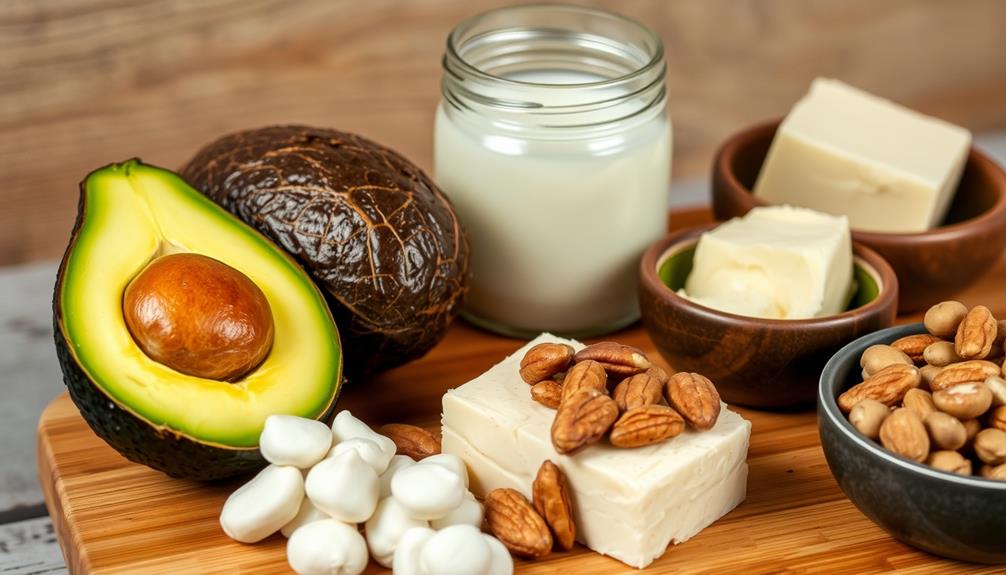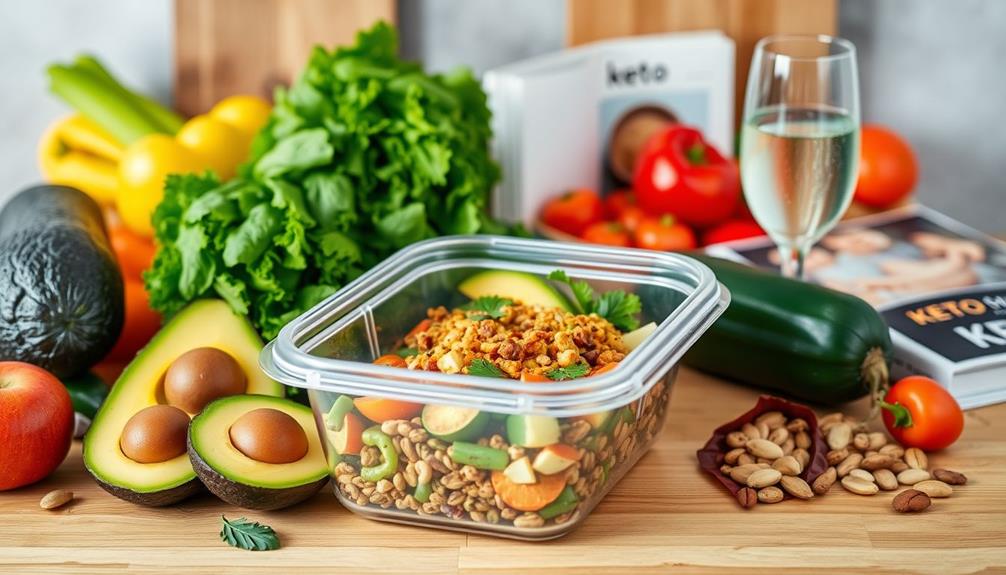To count carbs on the keto diet, focus on net carbs rather than total carbs. Calculate net carbs by subtracting fiber and certain sugar alcohols from total carbs. Aim for 20 to 50 grams of net carbs each day to keep ketosis intact. Pay close attention to nutrition labels and consider using apps or food diaries to track your intake accurately. Opt for low-carb foods like leafy greens, proteins, and healthy fats to satisfy your hunger. As you adjust, you'll discover tips and tricks to make carb counting easier and more effective for your keto journey.
Key Takeaways
- Calculate net carbs by subtracting fiber and half of sugar alcohols from total carbs for accurate tracking.
- Aim for a daily intake of 20 to 50 grams of net carbs to maintain ketosis.
- Read nutrition labels carefully to differentiate between total carbs and net carbs.
- Use food diaries or tracking apps to enhance accountability and monitor carb intake effectively.
- Choose low-carb food options, such as vegetables and protein-rich foods, to stay within carb limits.
Understanding Carbohydrates
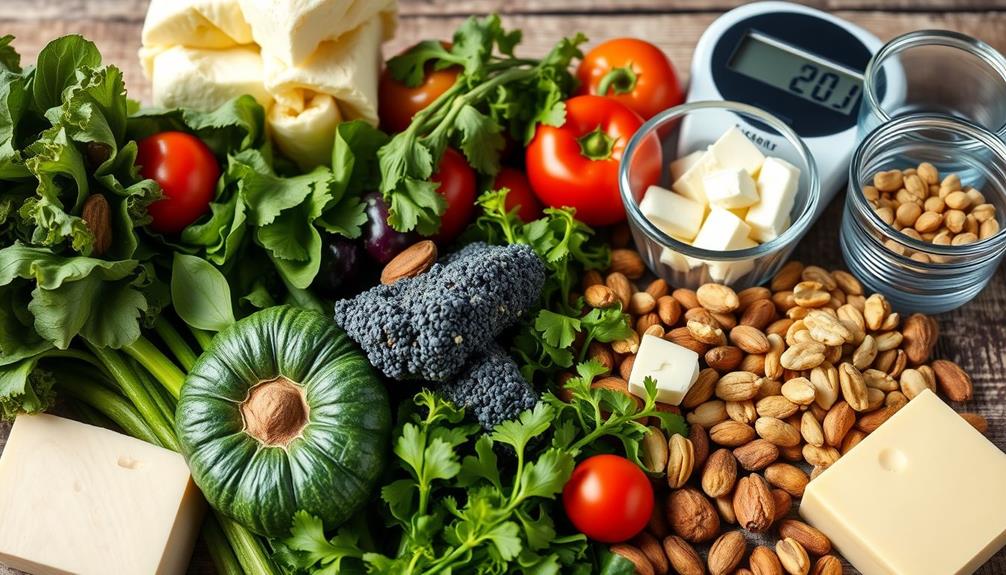
When starting your journey on the keto diet, it's vital to grasp the role of carbohydrates in your body. Carbohydrates are macronutrients that serve as your primary energy source, classified into sugars, starches, and fiber. Understanding the distinction between total carbs and net carbohydrates can greatly impact your success on keto. In addition, having a solid budget plan can help you allocate resources for quality food options that align with your dietary goals.
Total carbs include all forms of carbohydrates in food, encompassing sugars, starches, and fiber. However, not all carbs affect your body the same way. For those on a keto diet, you need to focus on net carbohydrates, which you can calculate by subtracting dietary fiber and certain sugar alcohols from total carbs.
This distinction is significant because dietary fiber doesn't raise blood sugar levels, making it less relevant for your carb count.
To maintain ketosis, your recommended daily intake of net carbs typically ranges from 20 to 50 grams, depending on your individual tolerance and activity levels. By understanding how to differentiate total carbs from net carbs, you'll be better equipped to manage your carbohydrate intake and achieve your dietary goals on the ketogenic diet.
Calculating Net Carbs

Calculating net carbs is fundamental for anyone following a keto diet, as it helps you understand how many carbohydrates your body actually absorbs. To calculate net carbs, use the formula: Net Carbs = Total Carbs – Fiber – (specific sugar alcohols). This formula reveals the digestible carbs that impact your blood sugar levels, which is essential for maintaining ketosis.
Additionally, being aware of the nutritional content of different foods can aid in making informed choices while on a keto diet, such as understanding the benefits of high-fiber options like celery juice to enhance your overall health.
For example, if a food item contains 21g of total carbs, 8g of fiber, and 6g of sugar alcohols, the net carbs would equal 7g. It's important to read nutrition labels carefully; while total carbs include all carbohydrates, only net carbs matter for your keto journey.
Utilizing apps and online calculators can help you track net carbs accurately, ensuring you stay within the recommended daily limit of 20-50 grams for ketosis. Remember, fiber doesn't affect blood sugar levels, so it's subtracted from total carbs when calculating net carbs.
Low Carb Food Options
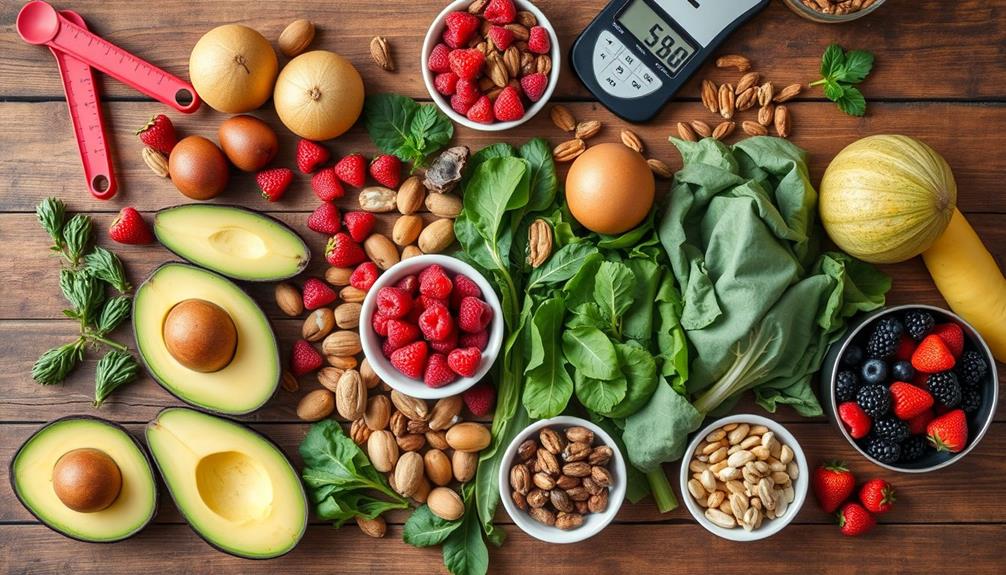
When you're on a keto diet, choosing low carb food options is essential for staying in ketosis.
Incorporating natural remedies alongside conventional medications can also support your overall health while managing cravings.
You'll want to focus on best low carb vegetables, protein-rich food choices, and satisfying low carb snacks.
Let's explore how these options can help you maintain your carb limits while enjoying delicious meals.
Best Low Carb Vegetables
In the quest for the best low carb vegetables on a keto diet, you'll find that options like spinach, cauliflower, and broccoli stand out for their impressive nutritional profiles. Spinach has just 1.43 g net carbs per 100 g, while cauliflower contains 2.97 g net carbs, making them both fantastic choices to keep you in ketosis.
Additionally, incorporating herbs like rosemary and peppermint oil can enhance your meals while providing health benefits, such as improved digestion and respiratory support essential oils for wellness. Broccoli, with 4.04 g net carbs per 100 g, is also a nutrient-rich option to include in your meals.
Don't forget about leafy greens like kale and lettuce, which are low in net carbs and high in fiber, perfect for filling up your salads. Zucchini, at only 2.11 g net carbs per 100 g, can be spiralized into zoodles, a great pasta substitute.
Bell peppers offer flavor and crunch with about 3.88 g net carbs per 100 g, making them ideal for stir-fries and salads.
Other excellent low carb vegetables include asparagus (1.79 g net carbs) and mushrooms (3.26 g net carbs), both nutrient-dense options that fit seamlessly into your keto diet. Incorporating these veggies will keep your meals satisfying and aligned with your low carb goals.
Protein-Rich Food Choices
For those on a keto diet, choosing protein-rich foods that are low in carbs is essential for maintaining ketosis and supporting overall health. Incorporating these foods into your meals can help you meet your protein intake goals while keeping net carbs low. Here are some excellent options:
| Food Item | Net Carbs (per serving) |
|---|---|
| Chicken | 0 grams |
| Salmon | 0-1 gram |
| Eggs | 0.76 grams |
| Cheddar Cheese | 2.44 grams |
| Greek Yogurt | 3.98 grams |
| Brazil Nuts | 4.24 grams |
| Flaxseeds | 1.58 grams |
Fresh meats like chicken, beef, and pork contain negligible carbs, making them ideal for your keto diet. Fatty fish like salmon and mackerel not only provide protein but also omega-3 fatty acids. Eggs are a versatile staple, while dairy options like cheddar cheese and Greek yogurt promote satiety. Nuts and seeds, such as Brazil nuts and flaxseeds, offer healthy fats and protein with low net carbs. These choices help you stay on track with your keto goals while enjoying a variety of flavors and nutrients.
Low Carb Snack Ideas
Snacking on a keto diet doesn't have to be boring or high in carbs. You can enjoy a variety of low-carb foods that satisfy your cravings while keeping your net carbs in check. Proper nutrition is essential for overall health, much like how ultimate hamster care emphasizes a balanced diet for small pets.
Fresh vegetables like celery and cucumber are excellent snacks; they're low in net carbs and high in fiber. Pair them with some cream cheese for an extra treat!
Cheese is another convenient option. With varieties like cheddar containing only about 1.3 g of net carbs per ounce, you can indulge without guilt. Nuts and seeds, such as almonds and flaxseeds, are also great low-carb snacks. Almonds offer 2.9 g of net carbs per ounce, while flaxseeds have just 1.5 g.
For a protein-packed option, try hard-boiled eggs. They're virtually carb-free and make for a filling snack.
Finally, unsweetened Greek yogurt can be a tasty choice too, with around 4 g of net carbs per 100 g serving. Top it with a few berries for some flavor without going overboard on carbs.
With these delicious low-carb foods to eat, you'll never feel deprived on your keto journey!
High Carb Food Dangers

When you consume high carb foods, you risk spiking your blood sugar levels, which can lead to increased cravings and hunger.
This can exacerbate emotional challenges similar to those experienced during the divorce process, making it harder to maintain control over your diet.
This not only disrupts your ketosis but also makes it harder to stick to your keto diet goals.
Understanding these dangers can help you make better choices and stay on track.
Impact on Ketosis Levels
High-carb foods can throw your body out of ketosis, making it tougher to burn fat effectively. When you consume more than the recommended 20-50 grams of carbs per day, you risk disrupting the delicate balance required for ketosis.
Foods high in carbohydrates like bread, pasta, and sugary snacks can rapidly elevate your blood sugar levels, leading to increased insulin production that counters your ketogenic efforts. Understanding the impact of your dietary choices is vital for maintaining healthy financial habits, similar to how protecting your savings is critical in investment strategies.
Even seemingly healthy options, like high-carb fruits such as bananas and apples, can derail your progress. Their natural sugars contribute to your total carbs, pushing you closer to that critical limit.
That's why it's important to track your net carbs—total carbs minus fiber. This will help you stay aware of what you're eating and avoid inadvertently consuming high-carb foods that jeopardize your ketosis levels.
Blood Sugar Spikes
The dangers of high-carb foods extend beyond just disrupting ketosis; they can also cause significant blood sugar spikes that derail your overall health. When you consume high-glycemic index foods like processed sugars and grains, your body rapidly absorbs glucose, leading to elevated blood sugar levels. This spike results in increased insulin production, which can contribute to weight gain and energy crashes shortly after eating.
Individuals with emotional dysregulation, such as those with Borderline Personality Disorder (BPD), may find that these blood sugar fluctuations exacerbate their symptoms, leading to intensified mood swings and impulsive behaviors.
When your carbohydrate intake includes high-carb foods, you risk raising your blood glucose levels by as much as 50-100 mg/dL within a couple of hours. Over time, these fluctuations can lead to insulin resistance, increasing your risk of developing type 2 diabetes. By focusing on net carbs and maintaining a low-carb intake on a keto diet, you stabilize your blood sugar levels and reduce the likelihood of these harmful spikes.
To promote fat utilization for energy, prioritize low-carb options and avoid sugary snacks and white bread. Keeping your blood sugar levels in check is essential for not only maintaining ketosis but also safeguarding your long-term health.
Increased Cravings and Hunger
Increased cravings and hunger often result from consuming high-carb foods, as these items cause rapid spikes and subsequent drops in blood sugar levels. When you eat high-carb foods, your body releases insulin to manage those spikes. This insulin surge not only promotes fat storage but also increases feelings of hunger, making it harder to control your appetite.
Additionally, just like dogs benefit from healthy snacks that promote overall wellness, humans can find satisfaction in low-carb alternatives that help curb cravings.
Research shows diets rich in refined carbohydrates lead to increased appetite and can cause you to consume more calories overall. These high-carb foods disrupt the balance of hunger hormones like ghrelin and leptin, trapping you in a cycle of cravings that's tough to break.
To manage your hunger effectively on a keto diet, you need to focus on limiting high-carb foods. By doing so, you allow your body to adapt to using fat as its primary energy source, which helps reduce overall appetite.
Tracking your net carbs is essential in this process, as it helps you stay within your limits and maintain ketosis. Ultimately, cutting back on high-carb foods is vital for keeping cravings in check and achieving your weight loss goals.
Health Benefits of Keto
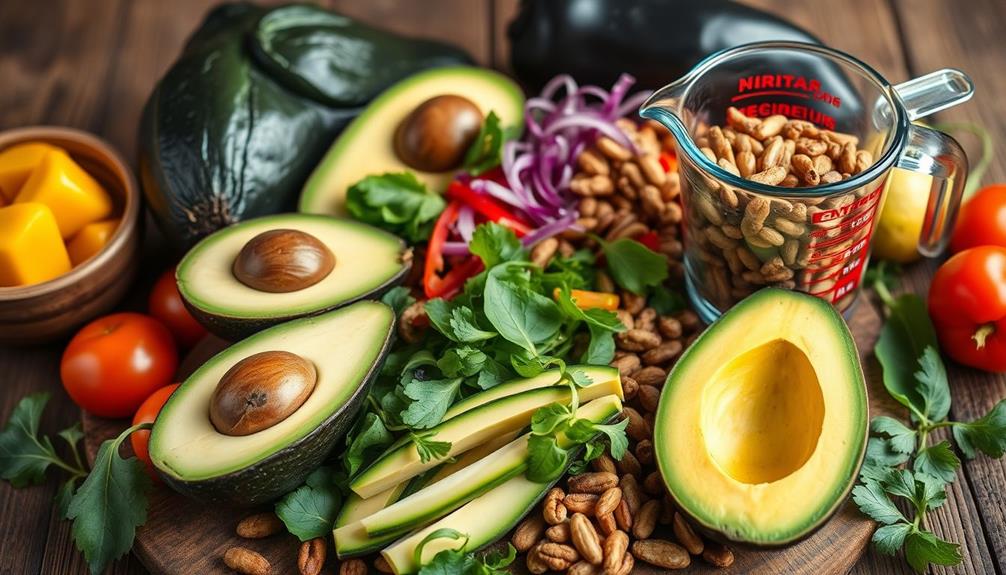
Embracing a ketogenic diet can lead to a host of health benefits that extend beyond weight loss. Many individuals experience significant reductions in body weight as the keto diet promotes fat-burning processes and helps manage hunger through its high-fat intake. This not only aids in shedding pounds but also supports overall wellness.
Additionally, opting for an energy-efficient heating solution like a high-performance unit can further enhance your comfort during dietary changes, as maintaining a stable environment is essential for achieving health goals.
One of the notable health benefits of keto is improved blood sugar control, making it particularly valuable for those with type 2 diabetes. By reducing insulin resistance and stabilizing glucose levels, you can better manage your health.
Additionally, following a ketogenic diet has been linked to decreased inflammation markers in the body, potentially lowering the risk of chronic diseases.
Heart health can also see improvements on a keto diet, with evidence suggesting increased levels of HDL (good cholesterol) and reduced triglycerides, both of which are vital for cardiovascular wellness.
Finally, some studies indicate that the keto diet may enhance mental clarity and cognitive function, offering neuroprotective benefits that could lower the risk of neurodegenerative diseases.
Dietary Challenges and Solutions

Steering through the ketogenic diet can be challenging, especially when it comes to managing cravings for high-carb foods. To tackle these hurdles effectively, consider the following strategies:
- Incorporate High-Fiber Low-Carb Snacks: Choose options like nuts and seeds to help curb your cravings and promote satiety.
- Stay Hydrated: Combat the "keto flu" by drinking plenty of water and consuming electrolyte-rich foods such as avocados and leafy greens.
- Track Your Net Carbs: Use apps or printable cheat sheets to keep an eye on your daily net carb limits, ensuring you make informed food choices.
- Plan for Social Situations: Review menus in advance or bring your own keto-friendly snacks to parties and gatherings to stay on track.
Long-term success on the keto diet often depends on how well you navigate these challenges.
Experiment with new low-carb recipes and embrace meal-prepping to keep your meals exciting and aligned with your dietary goals.
Meal Preparation Tips

Meal prepping can be a game-changer for maintaining a keto diet, especially since it guarantees you always have low-carb meals on hand. By preparing your meals in advance, you'll reduce the temptation to reach for high-carb options when hunger strikes.
Start by focusing on low-carb vegetables like leafy greens, broccoli, and cauliflower; these veggies are nutritious and keep your meals within your carb limits.
Utilize portion control as you measure out servings of protein sources such as meat, poultry, and fish. This way, you'll meet your daily protein needs while keeping an eye on your net carbs.
Don't forget to incorporate healthy fats into your meal prep! Olive oil, avocados, and nuts are great choices that help you achieve the high-fat ratio necessary for a ketogenic diet.
Keeping a keto-friendly food list handy can make meal prep even easier. This list will guide you in selecting ingredients that align with your carb and macronutrient goals, ensuring you stay on track throughout the week.
With these tips, you can make meal prep a breeze and enjoy delicious, low-carb meals that support your keto lifestyle.
Tracking Your Carb Intake
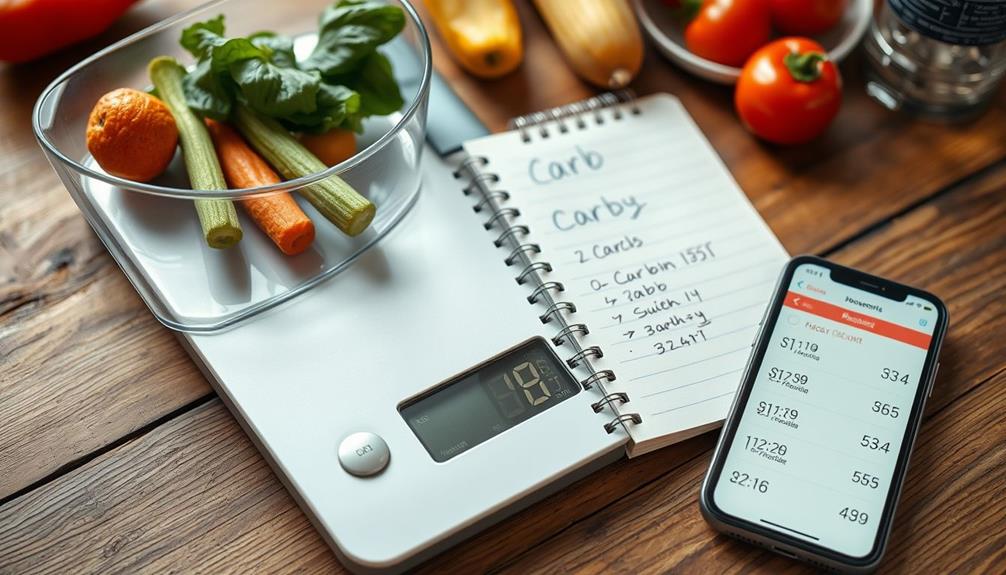
Having your meals prepped is just the first step in successfully following a keto diet; keeping track of your carb intake is equally important.
To stay in ketosis, you need to focus on counting net carbs, which means subtracting fiber content and half the sugar alcohols from total carbohydrates. Aim for a daily net carb limit of 20-50 grams, with most people benefiting from 20-25 grams.
Here are some tips to effectively track your carb intake:
- Read Nutrition Labels: Always check total carbohydrates, dietary fiber, and sugar alcohols to calculate your net carbs accurately.
- Use Apps or Calculators: Consider utilizing keto-specific tracking apps or online calculators to simplify the process and monitor your daily intake.
- Keep a Food Diary: Document what you eat to maintain awareness of your carb consumption throughout the day.
- Utilize Printable Cheat Sheets: These can help you stay organized and quickly reference carb counts for common foods.
Frequently Asked Questions
How Do I Calculate Carbs on Keto?
To calculate carbs, start with total carbohydrates then subtract dietary fiber to find net carbs. For processed foods, consider sugar alcohols too. Check labels and use apps for accurate tracking and managing your intake.
How Many Carbs per Day on a Keto Diet?
Think of carb limits like a tightrope; you've gotta balance. On a keto diet, aim for 20 to 50 grams of net carbs daily. Adjust based on your activity level to maintain ketosis effectively.
How Many Carbs Will Break Ketosis?
Exceeding 50 grams of net carbs daily usually breaks ketosis for most people. However, your tolerance might allow up to 100 grams, depending on factors like your activity level and metabolic health.
What Do 50 Grams of Carbs Look Like on Keto?
Fifty grams of carbs on keto can look like 10 cups of leafy greens, a couple of medium avocados, or two cups of broccoli. You'll need to choose wisely to stay within your limit.
Conclusion
As you navigate your keto journey, remember that counting carbs isn't just about numbers—it's about transforming your relationship with food. Every meal is a choice, a step toward a healthier you. But what happens when temptation strikes? Can you resist the allure of high-carb treats? The secret lies in preparation and mindfulness. Stay vigilant, keep tracking, and embrace the challenge. The rewards are waiting, but only if you dare to stay the course. Are you ready to unfasten your potential?



